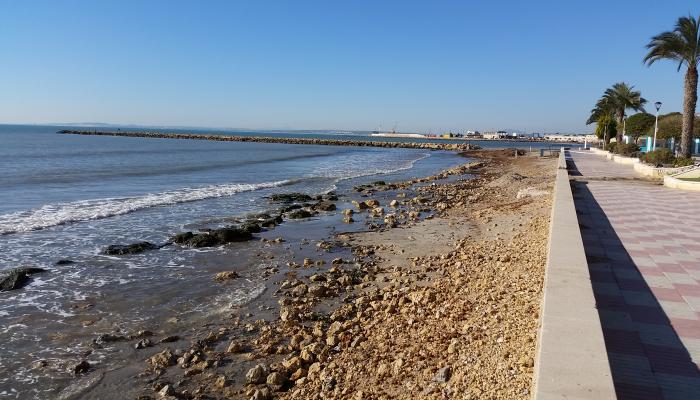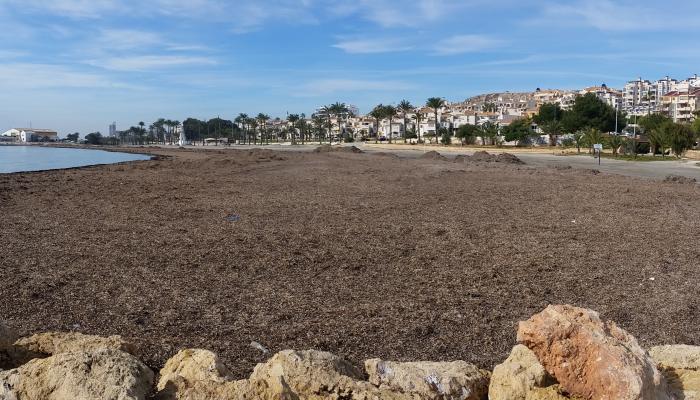
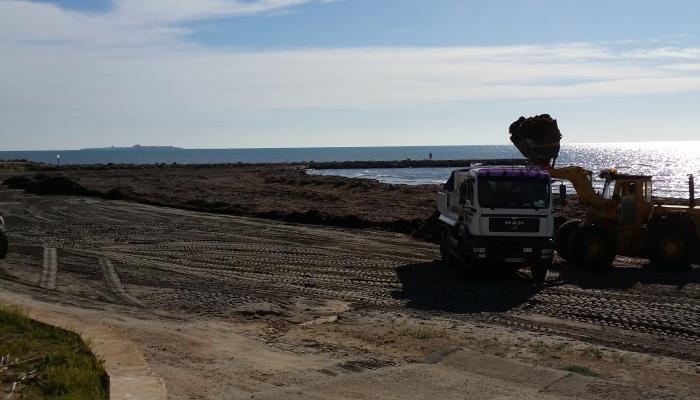
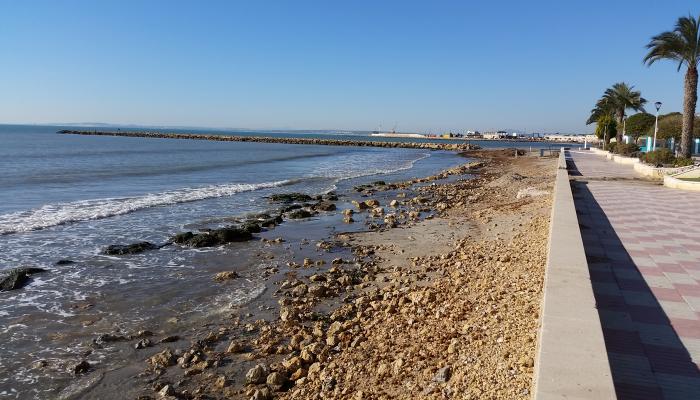
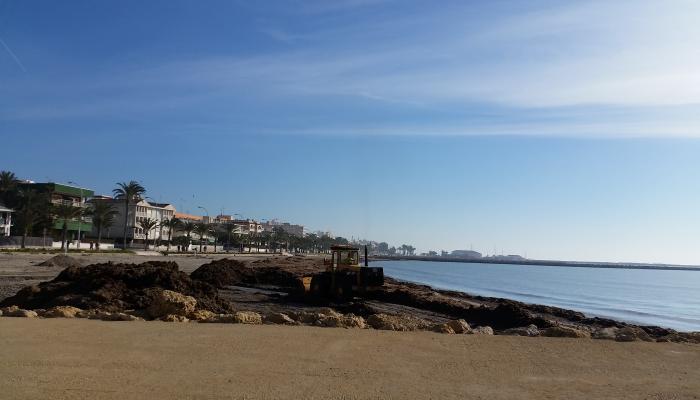
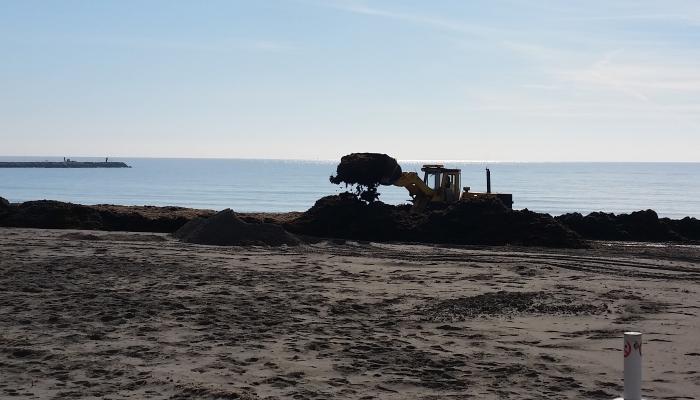

study of the coastal morphology in Santa Pola, with an analysis of the coastal configuration of the municipality, measuring the
the width of the beaches with GPS and studying their bathymetric profile with side scan sonar.
with side scan sonar
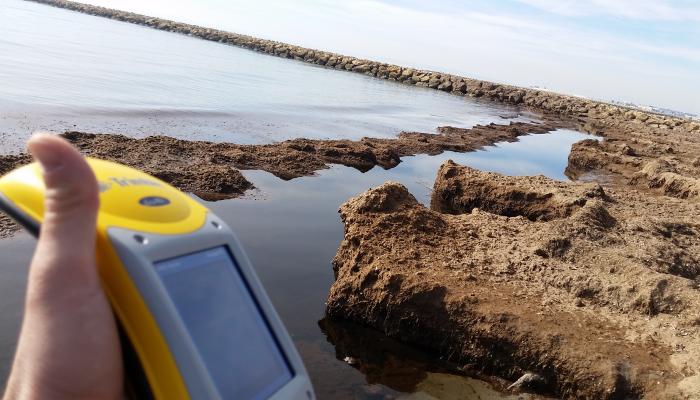
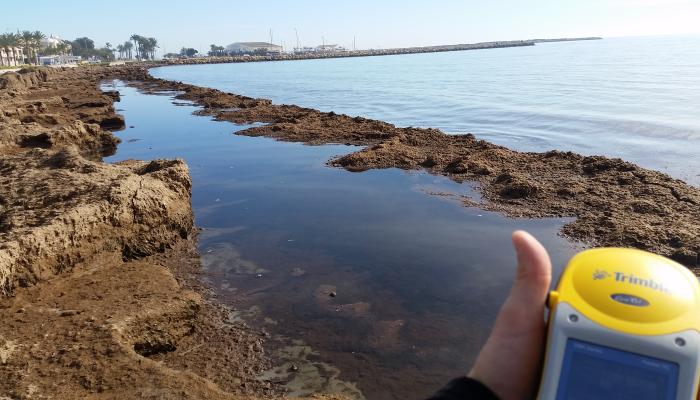
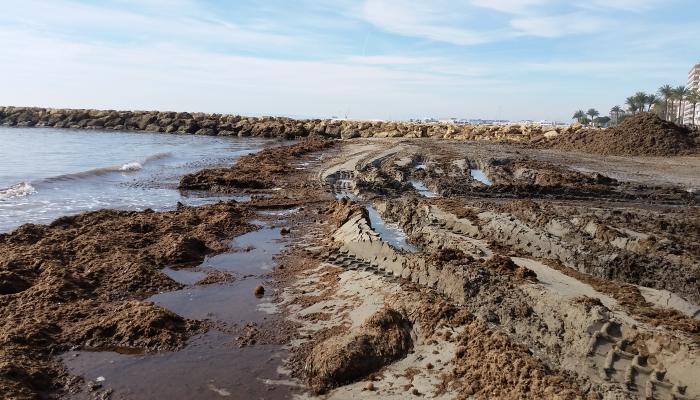
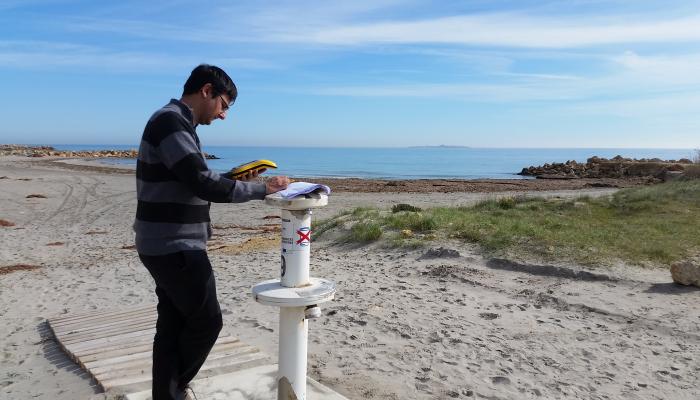
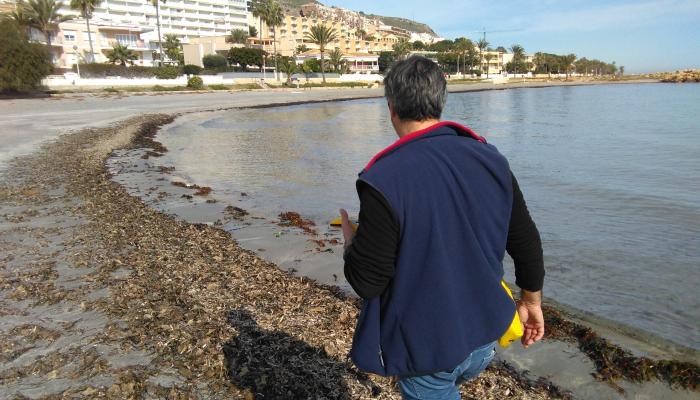
The GESTARR project analyses the role of Posidonia oceanica in the adaptation of coasts to climate change.
Beach management must be carried out with the problems arising from coastal erosion and adaptation to climate change among its objectives. A very important problem in beach management from a social, environmental and social point of view is the landslides of plant material that accumulate on the beaches, mainly from the marine phanerogams Posidonia oceanica and Cymodocea nodosa.
The project focuses on solving the problems of municipal management of plant material arrivals, mainly from the marine phanerogam Posidonia oceanica, which accumulates on the beaches in localities economically and socially dependent on tourism. To this end, two pilot municipalities were selected: Santa Pola and El Campello, in Alicante, in which coastal processes and their effects due to natural events or human actions were studied.
It also develops a methodology for beach monitoring that responds to managers' information demands regarding their dynamism and evolution. This will help design a policy for the long-term conservation of ecosystem services in line with the needs of the tourism sector.
Rising sea levels and maritime storms caused by extreme weather events are the effects of climate change that have the greatest impact on beaches. Both factors contribute to coastal erosion. This coastal erosion is a phenomenon consisting of the permanent retreat of the shore, which can be seen over time, causing the disappearance of some beaches. In this sense, it is estimated that climate change will produce a retreat of at least 1.8 m on the beaches of the Mediterranean coast.
The presence of landslides on the coastline cushions the impact of waves on the shore, controlling erosion and sand loss. The protection of the landings is especially effective during the autumn storms typical of the Mediterranean climate.
Although arribazones have a recognized role in protecting the coast against erosion, they are generally removed from beaches and coves, mainly for aesthetic reasons, in order to favor the exploitation of tourist activities. This extraction involves:
The loss of sand, since the extraction is carried out with heavy machinery, removing large volumes of sand collaterally. It is estimated that there is 93 kg of sand/m3 of landfall, which often ends up in landfills.
The increase in erosion, since, as mentioned above, the presence of landings on the coastline cushions the impact of the waves on the shore.
The loss of nutrients that the landings themselves represent as a supply of organic matter and nutritional elements for the dune systems associated with the beaches.
The ecosystem loss of a natural substrate on which many organisms and microorganisms develop that serve as food, among others, for crustaceans, molluscs and seabirds.
The main objective of the project is to obtain results that improve the condition of the beaches through sustainable management of these, seeking a balance between recreational use and environmental conservation, which in this case involves among other issues the proper management of the arrivals of Posidonia oceanica.
However, this main objective is also intended to:
Incorporate specific scientific-technical knowledge into beach management
Raising awareness among municipal beach managers of climate change
Raise awareness of the impacts of climate change on beaches and the role of marine phanerogams in mitigating it
The pilot project has been developed in two coastal municipalities: Santa Pola and El Campello, in the province of Alicante.
In Santa Pola, the project has monitored 8 urban beaches: Levante, Calas de Santiago Bernabéu (I, II and III), Varadero and Calas del Este (I, II and III).
In El Campello, work was carried out on the beach of Carrer de la Mar, with three study coves between the mouth of the port and the mouth of the Seco River.
In these pilot areas, coastal processes and their effects due to natural events or human actions have been studied. Likewise, a methodology for beach monitoring has been developed that seeks to respond to managers' demands for information on dynamism and evolution. The results of the monitoring show a generally positive evolution over the last year, although it is necessary to continue collecting data to obtain a historical series that provides accurate information.
Awareness-raising activities have also been included, in the form of the publication of a general awareness-raising guide entitled "Posidonia and Climate Change" and another aimed at professionals "The role of Posidonia oceanica in adaptation to climate change. Guide for beach managers". All these actions have been completed with an outreach activity, a travelling exhibition entitled "Posidonia and Climate Change".
One of the expected impacts on our coasts is the disappearance of beaches due to coastal erosion.
Given that the meadows of Posidonia oceanica and the arribazones, produced by the arrival of their own plant remains on the coast, naturally slow down the erosive effects on it, protecting the meadows and carrying out correct management of the arribazones is a measure of adaptation to climate change.
Posidonia oceanica meadows naturally prevent erosion of the coast, especially of beaches. This protection function is performed at several levels:
Its roots and rhizomes promote the retention and fixation of sediments.
Its blades reduce the current's speed and decrease the waves' energy and, therefore, the force with which they reach the shore
Its remains, deposited on the beach as landslides, attenuate the force of the waves and protect it from coastal erosion, preventing the loss of sand due to the effect of the waves.
Keeping the landings in place is the best solution from an ecological point of view and should be done when there is no conflict with bathing requirements and the beaches are subject to erosion processes.
The coastal zone should be considered as a natural and living environment, not just as an "asset" of the local recreational offer, which must be kept clean. For this reason, the management of algae and other plant remains on the beach must be carried out in a sensitive way, both to the needs of the visitor and to the maintenance of biodiversity.
To make tourist uses and conservation compatible, the arrivals can be removed during the summer season, from May to October, although it is recommended that this be shortened from June to September in the case of the Spanish Mediterranean. Therefore, elimination should be avoided during winter and spring, when storms are more likely to occur and the presence of arrivals is more necessary to cushion the effect of the waves on the beach.
A whole series of activities have been carried out in both locations:
Technical: The technical activities carried out can be summarised in three areas:
Study of coastal morphology.Analysis of the coastal configuration in both municipalities, measuring the width of the beaches with GPS with differential correction and studying their bathymetric profile with side-scan sonar.
Modelling of coastal dynamics. A coastal modelling system has been developed, implementing an approved model of coastal dynamics adapted to the local conditions of the pilot municipalities.
Coastal management of Posidonia oceanica landings. Monitoring and control of landings deposited on the beaches, as well as the cleaning operations carried out by the operating companies and analysis of the effects of beach maintenance work.
Informative and/or awareness-raising:
Guide for the awareness of beach managers. Preparation of a guide of good practices to raise awareness among municipal managers about the role of Posidonia oceanica in the balance of the coastal dynamics of their municipalities and its importance in adapting to climate change.
Environmental education campaign. Design of a travelling exhibition on the effects of climate change on Posidonia oceanica meadows and their role in the adaptation of coastal areas.
Dissemination of results. The results obtained have been published on the website of the Institute of Coastal Ecology (IEL) and have been widely disseminated in the press. They were also disseminated through the traveling exhibition, developed with a reach of more than 600 people in municipalities with problems of management of arrivals and through distributed brochures and published papers and scientific works.
Protecting the coastal meadows of Posidonia oceanica and carrying out a correct management of its landings on the beaches are an important measure of adaptation to climate change.
The maintenance of the landings is a substantial element for the protection of the beaches, which can also be used according to their seasonality. In addition, the underwater meadows of Posidonia oceanica themselves reduce turbulence, the force of the wave when it reaches the coast.
Fortunately, the high season of massive use of the beaches by users coincides with a period where there are usually no storms; however, during the autumn-winter low season, no systematic removal of arrivals should be carried out.
In this sense, coastal protection increases during the low season, with a greater loss of sediments estimated otherwise, that is, if they had been removed during the period with greater hydrodynamic activity. However, its removal only during the high season, together with the occasional contribution of sand during the year and beach cleaning operations, do not seem to have a counterproductive effect on the dynamics of the beaches.
The seasonal use of the arribazones in this sense would constitute a technique for the sustainable protection of the beaches, consisting of carrying out their selective extraction on certain beaches and periods of the year. They would be left to act as a plant biological barrier for as long as possible, acting as sand retainers and elements of protection against waves, as well as as a biological substrate that favours biodiversity.
During the period in which the cleaning operations are carried out, the fraction of landings located in the area of contact with the sea are removed last, extending their protective effect as much as possible over time.
The GESTARR project focused mainly on the municipal management of plant landings, especially Posidonia oceanica.
The project was developed by the Institute of Coastal Ecology Foundation, located in El Campello (Alicante), with the participation of two municipalities particularly affected by different coastal processes and by the effects produced by natural events or human actions on their coastal strip.
For its execution, it was funded through the Biodiversity Foundation, under the Ministry of Ecological Transition (MITERD).
Among the results obtained, the coastal dynamics report includes the simulation of the prevailing waves. This has characterized the behavior of the coastal dynamics in the area, which helps to know the areas that experience less and greater dynamism during episodes of maritime storms.
Observations have been made on the beaches themselves, and a database has been created that collects the measurements made periodically on them in order to monitor changes in their width and submerged bathymetric profile to know the evolution of the seabed. This information is related to human interventions, such as the extraction of landings and the contribution of sand obtained from their screening.
At the level of Santa Pola, the results showed a generally positive evolution. 25 transects were made between all the beaches, the width of the dry beach using GPS. 76% of the transects showed a positive or stable trend. The data obtained in the submerged profiles confirm that the coastal currents in an East-West direction favour the transport of sediments towards the of Vatasa and the port of Santa Pola, causing a significant accumulation of sand on the bottoms of the beaches of Levante (20,000 m3) and Varadero (2,600 m3), which favours the replacement of sand naturally on the dry beach when calm conditions occur. Some of the observations have been conditioned by both maritime storms and heavy rains.
At the level of El Campello, the general coastal area has a relatively wide platform, where sandy substrates predominate, among which small formations of rocky bottoms stand out. The project monitored the beach of Carrer de la Mar, with three study coves between the mouth of the port and the mouth of the Seco River, establishing 12 transects and carrying out 4 bathymetric profiles, recording up to 2,400 GPS positions and up to 1,400 bathymetric points. This coastal stretch is heavily anthropized, with a large number of obstacles (dikes and breakwaters) for sedimentary transport. The presence of the port to the north and the breakwaters scattered along the beach, section the coastline causing small recirculations in each of the coves.
The distribution of sand varied throughout the period studied, moving throughout the submerged profile. 75% of the transects showed a positive or stable trend, although the observations may be conditioned by the lack of significant storms during the study period. The greatest loss of sand occurred in the southernmost section of the beach. The dry beach presented average variations in width of up to 21 m in the most affected section.
With the data obtained, it is possible to model and monitor the behaviour and evolution of these beaches, estimating their potentially more energetic areas and consequently determining areas conducive to the detachment, due to the effect of the incident waves, of plant material from the meadow. Thus, depending on the behaviour patterns of the currents, generated by the incident waves, it is possible to identify potential areas to host plant arrivals.
In both locations, the usefulness of these landings on the coastline as a natural element of cushioning the impact of the waves on the shore has been verified, controlling erosion and loss of sand. The protection of landings is especially effective during the autumn storms typical of the Mediterranean climate.
The level of vulnerability changes within the same beach depending on the width in each area, the presence-absence of landings, which reduce the rise of the water sheet, discontinuities of the sand due to natural accumulations or deficits after erosion processes, as long as they have not been altered by anthropogenic activity. such as the movement of sediments or the removal of landings due to the action of cleaning machinery.
In Santa Pola, it does not seem advisable to provide sand obtained from the sieve of Posidonia in the months of March to May, as it is a favourable period for strong storms from the east and torrential rains, which favours the transfer of sand from the dry beach to the submerged profile.
In El Campello, the degradation suffered by the coastal meadows of Posidonia oceanica in recent years is evident, confirmed by the significant reduction in the number of landings on the coast.
More time series are needed to make it possible to have more data to allow the monitoring, control and evolution of these beaches and indirectly of the state of the nearby Posidonia meadows, estimating the volume of landings and taking advantage of their value as a contingent system of sediment retention and coastal protection.
The maintenance of arrivals during the low season has favoured the protection of the beaches. If sediments had been removed during the period with the greatest hydrodynamic activity, a greater loss of sediments would have been estimated.
The removal of arrivals only during the high season, the contributions of sand and the cleaning operations, do not seem to have counterproductive effects on the dynamics of the beaches. It could be said that the techniques applied are sustainable, consisting of carrying out selective extraction on certain beaches and periods of the year.
In the first phase, the collection system consists of extracting the arrivals from the interior to the seashore. In this way, the vegetation barrier is allowed to act for as long as possible (sand retention, protection against waves, etc.) during the period in which the cleaning operations are carried out. The fraction of landings located in the area of contact with the sea, therefore, are the last to be extracted, dilating the protective effect over time.
In Santa Pola, the beaches where the highest concentration of landings has been recorded and where the Posidonia oceanica meadows are best preserved and closest to the beaches are those of Varadero and Calas del Este.
In El Campello, based on the observations made in the project:
arrivals are only removed on the beaches of Muchavista, Carrer La Mar, Almadraba and Amerador from a week before Easter until October 1.
in the same period and only if the hygienic and sanitary conditions so indicate, they are removed in the Enmig, Lanuza and Palmeretes coves.
they never leave under any circumstances on the beaches of Punta del Riu, Cala Piteres, Platja barranc d'Aigües-Lloma de Reixes, Llop Marí, Illeta dels Banyets and Platja del Carritxal.
Given the pilot nature of this project, developed in only two municipalities, and being necessary to have more data from time series and locations, which allow us to better define the pattern of behaviour of the beaches, it would be interesting to replicate it by covering new municipalities. This information would be particularly relevant for sustainable beach management.
The difficulty in managing the landslides, especially since the end of 2016, made it advisable to take measures to improve knowledge about the functioning of coastal dynamics in the municipalities of Santa Pola and El Campello, in Alicante, initiating an experimental project to monitor their coastal erosion. The observations began in January 2017 and lasted until February 2018.
The total cost of this project was €38,712.86, having been financed entirely with public funds through the 2017 call for grants of the Biodiversity Foundation, for the implementation of projects in the field of adaptation.
In the Spanish legal framework, there are no specific regulations on the removal of landings and/or plant remains deposited on beaches. However, we cannot forget their important ecological role in the coastal ecosystem, and even more so in the sedimentary balance of numerous beaches and coves. This role is clearly included in the guide of criteria to obtain the blue flag for beaches, which establishes as an imperative criterion that algae and remains of vegetation should not be collected, unless their accumulation and rot are clearly annoying and unhealthy.
The GESTARR project has lasted one year, developing in the period 2018-2019, although it was already based on the beach monitoring actions that began in advance, since January 2017, so it could really be estimated that there are about 2 years of execution.
Guillén J. et al. 2014. Guide to good practices for the management, collection and treatment of algae and marine plant arrivals on the coasts. Seamatter LIFE11 Project ENV/ES/000600. Coastal Ecology Institute. El Campello. 24 pp.
Ibarra Marinas D. et al. 2017. The impact of the conservation status of Posidonia oceanica on coastal erosion: the case of the beaches of l'Almadrava and Amerador (El Campello, Alicante). IX Conference on Coastal Geomorphology(Menorca, 2017). pp: 91-94.
IEL Institute of Coastal Ecology. 2019. Guide for beach managers "The role of Posidonia oceanica in adaptation to climate change. 13 pp.
IEL Institute of Coastal Ecology. 2019. Monitoring of Coastal Erosion on the Beaches of Santa Pola. Annual Report 2017-2018. Executive summary. 2 pp.
IEL Institute of Coastal Ecology. 2019. Characterization of the coastal dynamics of the beaches of El Campello. GESTARR Report. 66 pp.
IEL Institute of Coastal Ecology. 2019. Characterization of the coastal dynamics of the beaches of Santa Pola. GESTARR Report. 90 pp.
IEL Institute of Coastal Ecology. 2019. Dissemination guide "Posidonia and Climate Change". 16 pp.
IEL Institute of Coastal Ecology. 2019. Monitoring of the beaches of El Campello. GESTARR Report. 42 pp.
IEL Institute of Coastal Ecology. 2019. Monitoring of the beaches of Santa Pola. GESTARR Report. 70 pp.
- EXHIBITION: Posidonia oceanica and climate change.
- DISSEMINATION GUIDE: Posidonia oceanica and climate change.
- GUIDE FOR BEACH MANAGERS: The role of Posidonia oceanica in adapting to climate change.
- Gabriel Soler Capdepón
Scientific Director
IEL Institute of Coastal Ecology
C/ Santa Teresa, 50 - 03560 El Campello (Alicante)
Email: g.soler@ecologialitoral.com
Telephone: 965 657 690



